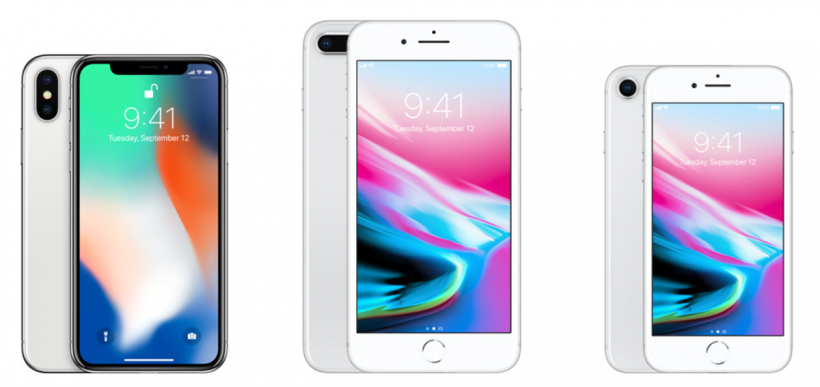Submitted by Marshall Walker on
Apple on Tuesday held its first ever keynote at the Steve Jobs Theater on its new Cupertino campus. After a brief tribute to the late Apple CEO, Tim Cook and team took to the stage to announce several new products. The next-generation devices unveiled on September 12, 2017 included the iPhone 8 and iPhone 8 Plus, and Apple's all-new "anniversary phone" aka the iPhone X or iPhone 10.
The iPhone X is one Apple's most expensive handsets starting at $999 while the iPhone 8 saw a price increase to $699. The new prices have made some longtime Apple customers wonder if it is worth upgrading this year. Here is a comparison of the iPhone 8 Plus and iPhone X to help you decide what to do when they go up for pre-order.
First of all, if you want the iPhone X you will have to wait until October 27, which is when pre-orders officially open. The new handset will not begin shipping until November 3rd, compared to the iPhone 8 which will begin shipping on September 22nd. The iPhone 8 is available in 3 colors (Silver, Gold, Space Gray) while the iPhone X is only available in 2 (Silver, Space Gray). All 3 models are available in only 2 storage capacities -- 64GB and 256GB. Here's the pricing breakdown for all three next-generation models:
iPhone 8
- 64GB - $699
- 256GB - $849
iPhone 8 Plus
- 64GB - $799
- 256GB - $949
iPhone X
- 64GB - $999
- 256GB - $1,149
iPhone 8 vs iPhone 8 Plus vs iPhone X (Display)
The biggest difference between the new iPhone models is screen size and design. All three include Apple's all‑new glass body, but the iPhone X features a larger 5.8-inch, edge-to-edge OLED screen which Apple is calling "Super Retina HD." The iPhone 8 and iPhone 8 Plus are equipped with a 4.7-inch and 5.5-inch Retina HD displays -- the same as their predecessor the iPhone 7 and iPhone 7 Plus. Resolution increases with each model at 1334-by-750 (326 ppi) for the iPhone 8, 1920-by-1080-(401 ppi) for the iPhone 8 Plus and 2436-by-1125 (458 ppi) for the iPhone X. The iPhone X also offers an impressive 1,000,000:1 contrast ratio plus more stunning colors, true blacks and high brightness.What really sets the iPhone X apart is its new edge-to-edge design. The iPhone X is the first iPhone model to ship without a physical Home button. This means iPhone X owners will need to use Apple's new Face ID technology to unlock their device, use Apple Pay and to keep their iPhone secure. Users will also need to learn all-new swipe controls to navigate their new phones. For example, instead of holding down the Home button to access the Home screen you will now have to swipe up from the bottom of your display. Swiping down from the top of your display will now access Control Center, and a swipe up with pause will allow you to access the App Switcher when you're using an app.
Newest iPhone FAQs
Hardware
All three models are powered by the same A11 Bionic chip with 64-bit architecture, and include a 12MP rear-facing camera, and 7MP front-facing camera. The iPhone 8 Plus and iPhone X have a few more advanced camera features, such as Portrait mode and Portrait Lighting, but they all support 4K video recording at 24 fps, 30 fps, or 60 fps. The iPhone X is the only device that ships with Apple's new new Animoji feature, and Face ID technology.
Other Features
For $300 extra you would think the iPhone X would offer more features, but it really doesn't. Besides Face ID, a few camera perks and a bigger and better display, all three next-generation models are pretty much the same. They're all waterproof, they all ship with Qi wireless support, 3D Touch, Siri, optical image stabilization, Apple Pay and all of Apple's other bells and whistles.
What iPhone is better?
It all depends on what you're looking for. The iPhone 8 is a decent successor to the iPhone 7. Most Apple fans will be willing to pay a little extra for wireless charging, and it includes all the same advanced hardware as the iPhone X. Deciding if you want to purchase the iPhone 8 or iPhone 8 Plus comes down to your preference in screen size, or what you can afford.
The iPhone X is for tech fans who are willing to pay a little more for the next big Apple product. We won't know for sure if Face ID is worth the extra money until the iPhone X begins shipping in November. The iPhone X does offer a big advance in screen technology, and its all new edge-to-edge design gives you more screen without adding any unnecessary bulk or weight. A lot of consumers asked Apple to increase its display, and they once again found a way to do it without compromising the sleek design of their flagship product.
